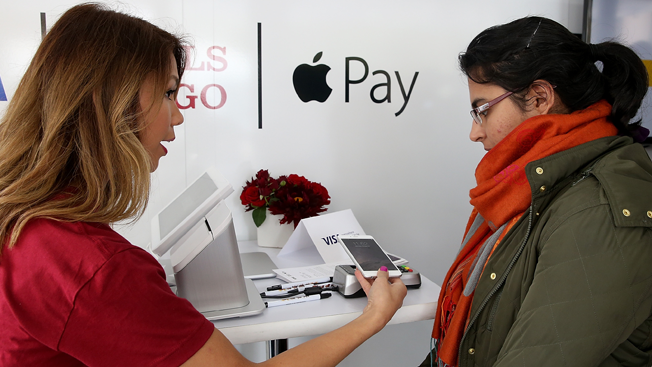
Apple Pay brought mobile payment into the mainstream. Photo: Justin Sullivan/Getty Images
Fueled by new ad formats and acquisitions from Facebook, Twitter and brands, mobile marketing finally began to step up to its potential this year.
From messaging and video to ultra-targeted ads and simplified shopping, smartphones and tablets became a major focus for most digital brands players in 2014.
Here are 10 of the biggest moves that made waves in mobile this year:
Mobile Video Becomes an Ad Format of ChoiceAfter much speculation, Instagram
unveiled sponsored videos this year, with Disney, Lancome and Banana Republic as the first names to test the ads.
Similar to its approach with
picture promos, Instagram vets each video ad to make sure that it's a fit for the platform.
Facebook-owned Instagram also hit 300 million users this year, cementing its appeal for social-savvy brands. According to data from Simply Measured, 86 percent of Interbrand top 100 brands had an account by the
third quarter of this year.
Meanwhile,
Twitter and
Tumblr built new video tools geared at mobile users. And in July, Yahoo acquired mobile firm Flurry to beef up its
video offerings.
"We're starting to see industries such as consumer-packaged-goods and entertainment studios that have traditionally been slow to shift budgets to mobile, now investing in mobile video content, as it allows for richer, more engaging advertising experiences," said Guillaume Lelait, general manager at mobile agency Fetch.
Twitter Embraces Social CommerceEighty-five percent—or $272 million—of Twitter's revenue came from mobile
during the third quarter this year.
In September, Twitter rolled out a buy button that marketers can plug into their tweets to drive sales. Twenty-five brands, including Home Depot and Burberry, were the
first to test the feature, pivoting it slightly away from a news site to a direct-response platform.
Twitter's buy button is one of several big advancements in social and mobile commerce this year—
Buzzfeed and
Tumblr rolled out similar features this year.
Beacons Catch On, But Risk BacklashApple first launched its iBeacon technology in 2013, but it gained a lot more attention this year thanks to campaigns from big-name brands like Walgreens,
Urban Outfitters and
Marriott.
The location-based tech, which sends ads to shoppers' smartphones, has also re-upped brands' investments in
mobile apps this year.
And according to Doug Rozen, chief innovation officer at Meredith Xcelerated Marketing, the push notifications that beacons send out are perceived more like advertising than brands realize. "Being triggered by inactivity, by location or by calendar, they are becoming viewed by consumers as ads more than marketers are treating them as such," he said.
Facebook Atlas Opens a New Trove of DataFacebook's
new Atlas ad server gives advertisers access to data about its 1.3 billion users.
Mobile advertising has long been held back by its lack of cookies, used to target ads on desktops. With the launch of Facebook Atlas, the social site hopes to push past that challenge by running digital ads outside of Facebook that tap into data about its users.
Mobile Payment Goes Mainstream With Apple Pay
Apple gave mobile payments a big boost this year with the launch of the iPhone 6 and digital wallet service Apple Pay, boasting the participation of brands like McDonald's, Nike and Target.
In November, the Cupertino, Calif.-based company revamped
its iAd business by signing deals with tech companies. Apple's new ads will incorporate Apple Pay, giving marketers a better chance at figuring out if a mobile ad actually persuaded someone to buy a product.
App Installs Become Ad Gold2014 was the year tech companies tried to catch up with Facebook on app install ads.
Twitter, Google and AOL have all rolled out ad formats this year that drive app installs for advertisers.
With the bulk of its competitors offering different variations on app install ads, Facebook started fine-tuning ad targeting earlier
this month.
App installs are a staple—and often lucrative—offering for traditional mobile ad networks, and with more marketers allocating mobile spend on social networks, it's no surprise that the social players want a cut of the spend.
Virtual Reality Goes MobileVirtual reality has been on marketers' radar for a few years, but it wasn't until
Facebook acquired Oculus in March that the technology started to build significant marketing buzz.
In its newest form, Oculus is powered by a
Samsung phone, which could help the technology gain traction with smartphone-toting consumers.
"Virtual reality has come to mobile with the Samsung Gear," said Jordan Gray, manager of creative labs at Organic. "
Game of Thrones and
Wrigley's were two notable brands that launched virtual reality experiences in 2014."
Snapchat Launches Self-Destructing AdsAt the same time that social mainstays like Facebook and Twitter grabbed for more mobile dollars, millennial-minded marketers were pleased when Snapchat started serving up its first ads
in October.
As more teens turn to the social messaging app to talk to each other, marketers like
Taco Bell and
Karmaloop have been aggressive in building a presence on the platform. But Snapchat has been reluctant to push paid promos to its users because of privacy concerns and its
lack of data that can be used for targeting.
The ads are opt-in and appear in the same section of the app where users watch Stories—strings of photos and videos that are viewable for one day after they are sent. "An advertisement will appear in your Recent Updates from time to time, and you can choose if you want to watch it. No biggie. It goes away after you view it or within 24 hours, just like Stories," Snapchat said
in a blog post announcing the ads.
Yahoo Makes Mobile Gains, Fueled by TumblrAfter reporting $200 million in mobile sales during the third quarter, Yahoo could pass Twitter as the
No. 3 mobile player next year, eMarketer predicts.
The research firm forecasts that Yahoo will make up 3.74 percent of mobile ad spend in 2015 (due in large part to Yahoo's $1 billion acquisition of Tumblr in 2013), while Facebook and Google will continue to dominate the space.
Per ComScore, Tumblr's mobile viewers were up 45 percent year-over-year in October, and the New York company reports that 65 percent of its users use its mobile app.
Tumblr has carved out a niche for itself in mobile with native sponsored posts and ads, but ad executives
are skeptical if the formats can move the sales needle.
Facebook's $16 Billion BetIn February, the Menlo Park, Calif.-based company bought mobile messaging app
Whatsapp for $16 billion to help build out Facebook Messenger.
The acquisition kicked off a slew of interest in mobile messaging as brands experimented with
Kik, Snapchat,
Whisper and Line.
Since its acquisition, Facebook has doubled down on messaging, including
a TV and
out-of-home advertising push this year.




